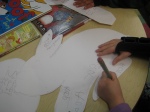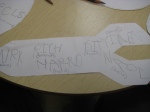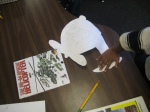Today was lesson 2 in a 3-part collaboration with Ms. Spurgeon’s PreK class. Last week, we read multiple examples of shape poems and wrote a model poem as a class. Today, students focused on writing their own poems. To prepare, Ms. Spurgeon and her parapro, Ms. Melissa, drew large shapes for each student and cut them out. These shapes were the symbols that each student uses in class to label various belongings. Each symbol has come to have special meaning to each student. I pulled nonfiction and fiction books related to each symbol so that students could reference the books for words to put inside their shapes.
I opened today’s lesson by reading a poem from Joyce Sidman’s Meow, Ruff: A story in concrete poetry. I used this as a reminder to students that the words that go inside the shape must somehow represent the shape. Ms. Spurgeon and I found that it was a common mistake for students to want to put whatever words were in their heads instead of focusing on their shape. She reiterated my opening by sharing a poem that she wrote about chocolate and reminding students that all of her lines were about chocolate.
Next, students each received the books about their symbol and proceeded to 3 work spaces where the pre-cut symbols were already out at chairs. Ms. Spurgeon, Ms. Melissa, and I each went to these areas and sat with students as they worked. Students began by looking through their books for ideas from the pictures or reading the words with adult assistance. As they decided on words, students sounded out words and wrote their words inside the shapes with their best handwriting and spelling. Next, students read their lines to an adult and the adult wrote the correct spelling of each word in parentheses.
were already out at chairs. Ms. Spurgeon, Ms. Melissa, and I each went to these areas and sat with students as they worked. Students began by looking through their books for ideas from the pictures or reading the words with adult assistance. As they decided on words, students sounded out words and wrote their words inside the shapes with their best handwriting and spelling. Next, students read their lines to an adult and the adult wrote the correct spelling of each word in parentheses.
Ms. Spurgeon will continue this lesson by giving students time to finish their poem and add color to it. They will also practice reading their poems before part 3. The last part of this collaboration will be recording each student reading his/her poem on camera and sharing those videos on Teacher Tube.

I was surprised by how helpful having books about their symbols was for the students. Many got ideas from the pictures and several even used direct words from the text. For example, one girl wrote a poem about rabbits. In the picture, she got so excited when she saw that the rabbit’s ears were going down. This turned into a line in her poem that was actually written on the rabbit’s ear. Another student read her books about apples with Ms. Melissa. She took facts such as “apples can be made into applesauce” and “apples are mostly harvested in the fall” and used pieces of those lines in her apple shape.
I’ll be sharing more about our media center’s support of poetry writing in the coming days and weeks.































